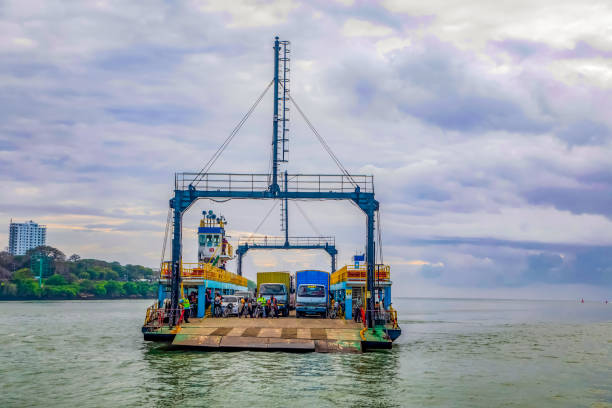1} PORT OF MOMBASA.The Port of Mombasa stands as the paramount maritime gateway in Kenya, playing a pivotal role in the nation’s economic development and regional trade dynamics.
Situated on the East African coast along the Indian Ocean, this strategic port has a rich history dating back centuries, initially serving as a crucial link in the global trade network.


Today, it remains a vital hub for both domestic and international commerce.One key factor contributing to the Port of Mombasa’s preeminence is its strategic geographical location. Positioned along major shipping routes, it serves as a natural gateway for goods entering and leaving the East African region.
This location enhances the port’s accessibility, making it an attractive choice for shipping lines and facilitating seamless connectivity to various global markets.
Infrastructure development has been a cornerstone of the Port of Mombasa’s success. Continuous investments have been made to enhance its efficiency and capacity. Modern container terminals, state-of-the-art handling equipment, and streamlined logistics processes have collectively positioned the port as a beacon of efficiency in the region.
This has not only expedited cargo handling but has also attracted international shipping lines and bolstered Kenya’s competitiveness in global trade.Moreover, the Port of Mombasa serves as a linchpin for landlocked neighboring countries, such as Uganda, Rwanda, and South Sudan, providing them with a vital maritime outlet.
This transit role solidifies the port’s significance, as it becomes an indispensable conduit for the region’s import and export activities, fostering economic growth and regional integration.The port’s adaptability to evolving global trade dynamics has also contributed to its leadership position.
Embracing technological advancements and implementing best practices in maritime management, the Port of Mombasa has positioned itself as a reliable and cost-effective transshipment hub.
The Port of Mombasa’s leading status in Kenya can be attributed to its strategic location, robust infrastructure, regional connectivity, and adaptability to changing trade landscapes. As a linchpin of East African trade, it continues to drive economic growth, serving as a testament to the crucial role maritime infrastructure plays in a nation’s development.
2} PORT OF KILIFI.The Port of Kilifi stands as a pivotal maritime gateway, playing a vital role in Kenya’s economic landscape. Strategically located along the country’s picturesque coastline, this port has earned its reputation as one of the leading maritime hubs in Kenya.
At the heart of its prominence is the port’s exceptional connectivity, serving as a linchpin for both domestic and international trade.
The Port of Kilifi boasts state-of-the-art infrastructure, including modern terminals and efficient cargo-handling facilities, enabling it to accommodate a diverse range of vessels. This capability ensures seamless import and export activities, fostering economic growth and trade sustainability.
Furthermore, the Port of Kilifi acts as a key facilitator for the transportation of goods to and from landlocked neighboring countries, enhancing regional trade dynamics. Its strategic location not only provides a gateway to the Indian Ocean but also positions it as a crucial link in the transshipment of goods, bolstering Kenya’s role in the global trade network.
In addition to its logistical advantages, the Port of Kilifi prioritizes operational efficiency and security. Advanced technology and stringent safety measures are implemented to safeguard both maritime activities and the environment.
This commitment to excellence has earned the port international recognition and compliance with global shipping standards.
The port’s impact extends beyond commerce, contributing significantly to local employment and socio-economic development. As a bustling center of economic activity, Kilifi has become a focal point for investment, attracting businesses and industries that benefit from its robust infrastructure and logistical capabilities.
The Port of Kilifi stands tall as a beacon of maritime excellence in Kenya. Its strategic location, world-class infrastructure, and commitment to efficiency have not only propelled it to the forefront of national trade but have also solidified its standing as a crucial player in the broader regional and global maritime landscape.
3} PORT OF LAMU.The Port of Lamu stands as a prominent maritime gateway, contributing significantly to Kenya’s economic vitality and regional connectivity.
Located on the northern coastline, it holds strategic importance due to its proximity to key shipping routes, facilitating trade not only for Kenya but also for neighboring countries. The port’s emergence as a leading maritime hub is attributed to several factors.
Firstly, its deep natural harbor allows for the berthing of large vessels, accommodating diverse cargo types. This enhances the port’s versatility, attracting international shipping lines and fostering trade relationships.
Additionally, ongoing infrastructure investments, such as modern terminals and efficient cargo handling facilities, have bolstered the port’s capabilities, ensuring swift and secure transit of goods.
Moreover, the Port of Lamu plays a pivotal role in the realization of the Lamu Port-South Sudan-Ethiopia-Transport (LAPSSET) Corridor, a transformative regional project. This corridor aims to connect landlocked East African countries to the Indian Ocean, reducing dependence on traditional routes and enhancing economic prospects for the entire region. The Port of Lamu serves as a linchpin in this corridor, symbolizing Kenya’s commitment to fostering regional integration and trade.
Furthermore, the implementation of cutting-edge technology and streamlined logistical processes at the port has heightened efficiency. Real-time tracking systems, automated customs procedures, and state-of-the-art security measures contribute to a seamless and secure flow of goods.
This has attracted businesses and investors, further solidifying the port’s position as a hub for international trade.
The Port of Lamu’s ascendancy as a leading port in Kenya is a result of strategic geographic positioning, ongoing infrastructure investments, and its integral role in regional development initiatives. Its impact extends beyond national borders, playing a pivotal role in enhancing trade dynamics and fostering economic growth throughout East Africa.
4} MALINDI BAY PORT.Malindi Bay, situated along the picturesque Kenyan coastline, has emerged as a pivotal maritime hub, establishing itself as one of the leading ports in the country. This strategic significance can be attributed to a combination of geographical advantages, economic factors, and infrastructural developments.
Geographically, Malindi Bay enjoys a prime location, offering natural protection from harsh weather conditions. Its sheltered waters make it an ideal harbor, reducing the risk of navigational challenges and providing a safe haven for vessels. This geographic advantage enhances the bay’s appeal for maritime activities, facilitating efficient and secure trade operations.
Economically, Malindi Bay plays a crucial role in Kenya’s trade dynamics. The port serves as a gateway for both imports and exports, contributing significantly to the national economy. Its proximity to key economic centers, coupled with well-established transportation networks, ensures seamless connectivity to various regions within Kenya and neighboring countries.
This accessibility enhances the efficiency of cargo movements and positions Malindi Bay as a preferred port for international trade.Infrastructure development has further bolstered Malindi Bay’s prominence. Investment in modern port facilities, including state-of-the-art container handling equipment, warehousing facilities, and customs services, has streamlined operations.
The implementation of advanced technologies for cargo tracking and management has enhanced efficiency, reducing turnaround times for ships and ensuring the timely processing of goods.Moreover, Malindi Bay’s commitment to environmental sustainability has garnered international recognition.
Efforts to minimize the ecological impact of port activities, coupled with initiatives to promote eco-friendly shipping practices, have positioned Malindi Bay as a responsible and forward-thinking maritime center.
Malindi Bay’s ascent to becoming one of Kenya’s leading ports is a result of a harmonious blend of geographical advantages, economic significance, and strategic infrastructure development. Its role as a key player in trade and commerce underscores its importance in the regional and global maritime landscape, fostering economic growth and connectivity for Kenya.
5} KIPINI PORT. Kipini Port is a prominent maritime facility in Kenya, strategically positioned to facilitate trade and economic activities. Situated on the Indian Ocean coast, it serves as a crucial gateway for both import and export activities, contributing significantly to Kenya’s economic development.
The port plays a pivotal role in enhancing regional connectivity by serving as a key point for shipping routes, fostering trade relationships with neighboring countries.With state-of-the-art infrastructure and modernized facilities, Kipini Port efficiently handles various types of cargo, including containers, bulk commodities, and general goods.
Its strategic location enables it to cater to the needs of industries, businesses, and consumers, promoting commerce and supporting the growth of the national economy.Kipini Port’s efficient operations, coupled with streamlined logistics and transport networks, make it a preferred choice for businesses seeking reliable and cost-effective trade routes.
The port’s contribution extends beyond national borders, fostering regional integration and cooperation, thereby enhancing economic ties in the East African region.
Kipini Port’s leading position in Kenya is attributed to its strategic location, modern infrastructure, and pivotal role in facilitating international trade, making it a key player in the country’s economic landscape.
